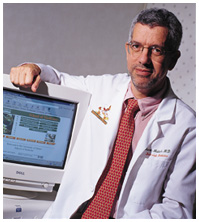|
|
| E-Medicine More than Meets the Eye |
|
The most obvious change is the instant availability of an enormous amount of information about health and health care. Patients come into their doctor’s office having read the lead article in next week’s edition of the New England Journal of Medicine on the Web. A few seconds’ effort is sufficient to find hundreds of Internet sites related to hypercholesterolemia and hundreds more on its many treatments. Just as many sites will “prove” the fraudulent connection of cholesterol and heart disease.
Unfortunately, few patients are trained in assessing the scientific facts of the claims as opposed to their advertising value (what does this former football player know about the treatment of heart disease?). As patients, we need to find ways to validate the information we are retrieving. We can do this by going to reliable sites that publish information based on scientific review. Sites that do this will explain the data, why it is valid, and in some cases, why it may not be valid. Sites such as the National Institutes of Health, many medical schools, and reputable medical journals critically analyze information submitted to them before publishing anything. Few patients are able to assess their own symptoms and physical findings and make a diagnosis. Physicians’ ability to make a correct diagnosis is a skill honed over many years of seeing numerous patients. Patients need to assess whether the information they are reading really applies to their situation. Is the headache I am experiencing really a brain tumor, or is it a tension headache? The applicability to the individual patient is even more complex. The choice of which therapy to use for a given patient may require the consideration of 30 or 40 different aspects of the individual patient. As a patient, I am unlikely to know all of those factors. All of these problems point to one solution. The relationship between the patient and provider will become even more important. As patients we need to ask our physicians to help guide us through the ocean of information. The provider will need to accept the increased knowledge their patients bring to the table, whether it is relevant or not, and assist the patient in understanding it. Questioning by patients should not be viewed as threatening or a nuisance; rather, it should be welcomed and seen as an opportunity to help patients participate in their care. Physicians can direct patients to sites they consider reliable. No discussion of e-medicine would be complete without a caution for the e-patient—privacy! As consumers, we need to remember that our lives on the Internet are extremely public. Our moves from site to site are closely tabulated and recorded. E-mail communications, rarely using any security measures, are usually fairly easily accessed by individuals and organizations other than the intended physician. You need to consider whether you wish to discuss your complaint in an e-mail communication. The good news: even as we read this, the Internet is changing rapidly. The government is finalizing guidelines to ensure greater privacy for health-related data. |
|
|
| Mark Multach, M.D. ’82, is associate professor of clinical medicine; chief, Division of General Medicine; and vice chairman for clinical affairs in the Department of Medicine. |
|
|
|
|
|
|
|
|
|
|
 Therein
lies the first major difficulty in using the Internet—the overabundance
of unfiltered, unreviewed information. Patients are coming upon huge
volumes of information, all purported to be scientific, on symptoms,
tests, diseases, medications, home remedies, and cures.
Therein
lies the first major difficulty in using the Internet—the overabundance
of unfiltered, unreviewed information. Patients are coming upon huge
volumes of information, all purported to be scientific, on symptoms,
tests, diseases, medications, home remedies, and cures.